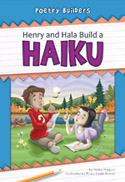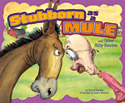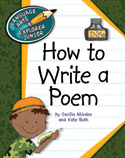Ways with Words: Language Arts | Series Made Simple Spring 2011
 Read Series Made Simple, School Library Journal's guide to the latest series nonfiction
Read Series Made Simple, School Library Journal's guide to the latest series nonfiction
Today, writing and research assignments can be found across the curriculum. Students may craft nature poems for science class, send emails to community leaders in civics, or write letters to historical figures in social studies. The series in this section will assist those who want to put a creative touch to their compositions.
Preschool—Grade 4
 BULLARD, Lisa. Nina and Nolan Build a Nonsense Poem. illus. by Patrick Girouard. ISBN 978-1-59953-437-4. LC 2010043870. HEIDEN, Pete. Penelope and Pip Build a Prose Poem. illus. by Amy Huntington. ISBN 978-1-59953-438-1. LC 2010043868. HIGGINS, Nadia. Henry and Hala Build a Haiku. illus. by Brian Caleb Dumm. ISBN 978-1-59953-435-0. LC 2010043866. MATAYA, Marybeth. Luke and Leo Build a Limerick. illus. by Ilene Richard. ISBN 978-1-59953-436-7. LC 2010043867. PETERSON-HILLEQUE, Victoria. Ana and Adam Build an Acrostic. illus. by Winifred Barnum-Newman. ISBN 978-1-59953-433-6. LC 2010043211. STJOHN, Amanda. Sophie and Sadie Build a Sonnet. illus. by Luanne Marten. ISBN 978-1-59953-440-4. LC 2010043871. ea vol: 32p. (Poetry Builders Series). illus. further reading. glossary. Web sites. CIP. Norwood House. 2011. PLB $18.95. Gr 2-4—These titles use stories to explain how to create different poetic forms. Each book opens with a letter from one of the characters, providing background information about the particular form. For example, in his missive in Nonsense Poem, Nolan writes that he thought that poetry had to be serious, but that Nina showed him how “You play with words and sounds. You play with word meanings.” The bulk of the books consists of a fictional story in which a cast of multicultural characters write and share poems. Unfortunately, the stories lack suspense and will not capture readers’ interest, and the format isn’t successful at imparting the information. Titles end with a spread that gives students instructions for crafting their own work. Each book has a different illustrator, and the quality and style of the art varies. On the plus side, the series includes some types of poetry—sonnets and nonsense and prose poems— that are not often covered in similar guides, especially in individual volumes.
BULLARD, Lisa. Nina and Nolan Build a Nonsense Poem. illus. by Patrick Girouard. ISBN 978-1-59953-437-4. LC 2010043870. HEIDEN, Pete. Penelope and Pip Build a Prose Poem. illus. by Amy Huntington. ISBN 978-1-59953-438-1. LC 2010043868. HIGGINS, Nadia. Henry and Hala Build a Haiku. illus. by Brian Caleb Dumm. ISBN 978-1-59953-435-0. LC 2010043866. MATAYA, Marybeth. Luke and Leo Build a Limerick. illus. by Ilene Richard. ISBN 978-1-59953-436-7. LC 2010043867. PETERSON-HILLEQUE, Victoria. Ana and Adam Build an Acrostic. illus. by Winifred Barnum-Newman. ISBN 978-1-59953-433-6. LC 2010043211. STJOHN, Amanda. Sophie and Sadie Build a Sonnet. illus. by Luanne Marten. ISBN 978-1-59953-440-4. LC 2010043871. ea vol: 32p. (Poetry Builders Series). illus. further reading. glossary. Web sites. CIP. Norwood House. 2011. PLB $18.95. Gr 2-4—These titles use stories to explain how to create different poetic forms. Each book opens with a letter from one of the characters, providing background information about the particular form. For example, in his missive in Nonsense Poem, Nolan writes that he thought that poetry had to be serious, but that Nina showed him how “You play with words and sounds. You play with word meanings.” The bulk of the books consists of a fictional story in which a cast of multicultural characters write and share poems. Unfortunately, the stories lack suspense and will not capture readers’ interest, and the format isn’t successful at imparting the information. Titles end with a spread that gives students instructions for crafting their own work. Each book has a different illustrator, and the quality and style of the art varies. On the plus side, the series includes some types of poetry—sonnets and nonsense and prose poems— that are not often covered in similar guides, especially in individual volumes.
 LOEWEN, Nancy. She Sells Seashells and Other Tricky Tongue Twisters. illus. by Donald Wu. ISBN 978-1-4048-6273-9. LC 2010033761. ————. Stubborn as a Mule and Other Silly Similes. illus. by Adam Watkins. ISBN 978-1-4048-6271-5. LC 2010033763. ————. Talking Turkey and Other Clichés We Say. illus. by Adam Watkins. ISBN 978-1-4048-6272-2. LC 2010033769. ————. You’re Toast and Other Metaphors We Adore. illus. by Donald Wu. ISBN 978-1-4048-6270-8. LC 2010033770. ea vol: 24p. (Ways to Say It Series). illus. further reading. glossary. index. Web sites. CIP. Picture Window. 2011. PLB $27.32. Gr 2-5—After a one-page explanation of the specific type of figurative language, these books launch into a story. The figures of speech always appear in a font different from the rest of the text to make them distinct. On each spread, text boxes explain how the figurative language in the story works and provide interesting trivia or historical notes. For example, in Tongue Twisters, readers learn that all languages feature these tricky phrases, and that in sign language, they are called finger fumblers. Each book concludes with a suggested activity. The titles on similes and metaphors include some examples not always found in materials for children, and Clichés and Metaphors also discuss idioms. Although these stories are definitely teaching tools, the full-spread illustrations help to contribute characterization and humor and make the books useful as classroom read-alouds.
LOEWEN, Nancy. She Sells Seashells and Other Tricky Tongue Twisters. illus. by Donald Wu. ISBN 978-1-4048-6273-9. LC 2010033761. ————. Stubborn as a Mule and Other Silly Similes. illus. by Adam Watkins. ISBN 978-1-4048-6271-5. LC 2010033763. ————. Talking Turkey and Other Clichés We Say. illus. by Adam Watkins. ISBN 978-1-4048-6272-2. LC 2010033769. ————. You’re Toast and Other Metaphors We Adore. illus. by Donald Wu. ISBN 978-1-4048-6270-8. LC 2010033770. ea vol: 24p. (Ways to Say It Series). illus. further reading. glossary. index. Web sites. CIP. Picture Window. 2011. PLB $27.32. Gr 2-5—After a one-page explanation of the specific type of figurative language, these books launch into a story. The figures of speech always appear in a font different from the rest of the text to make them distinct. On each spread, text boxes explain how the figurative language in the story works and provide interesting trivia or historical notes. For example, in Tongue Twisters, readers learn that all languages feature these tricky phrases, and that in sign language, they are called finger fumblers. Each book concludes with a suggested activity. The titles on similes and metaphors include some examples not always found in materials for children, and Clichés and Metaphors also discuss idioms. Although these stories are definitely teaching tools, the full-spread illustrations help to contribute characterization and humor and make the books useful as classroom read-alouds.
 MINDEN, Cecilia & Kate Roth. How to Write a Book Report. charts. ISBN 978-1-60279-992-9; ISBN 978-1-61080-028-0. LC 2010030064. ————. How to Write a Journal. ISBN 978-1-60279-994-3; ISBN 978-1-61080-030-3. LC 2010031317. ————. How to Write a Letter. ISBN 978-1-60279-991-2; ISBN 978-1-61080-027-3. LC 2010030062. ————. How to Write a Poem. ISBN 978-1-60279-995-0; ISBN 978-1-61080-031-0. LC 2010030066. ————. How to Write an E-Mail. ISBN 978-1-60279-993-6; ISBN 978-1-61080-029-7. LC 2010030065. ————. How to Write an Interview. ISBN 978-1-60279-996-7; ISBN 978-1-61080-032-7. LC 2010029824. ea vol: 24p. (Language Arts Explorer Junior Series). illus. photos. further reading. glossary. index. Web sites. CIP. Cherry Lake. 2011. PLB $24.21; ebook $24.21. Gr 2-5—After an introductory section describing the type of writing, subsequent chapters provide step-by-step instructions, including samples of student work. Book Report, Journal, and Poem provide general pointers, with the latter demonstrating how to write several types of poetry. Letter, E-mail, and Interview, however, each follow just one piece of writing from start to completion. Librarians should be aware that Book Report and E-mail are quite specific in their instructions, so the directions given may not mesh with every teacher’s style or with the software students are using. These titles are well-organized and feature an attractive layout; stock photos, colorful drawings, and text boxes with instructions break up the narratives and make them approachable.
MINDEN, Cecilia & Kate Roth. How to Write a Book Report. charts. ISBN 978-1-60279-992-9; ISBN 978-1-61080-028-0. LC 2010030064. ————. How to Write a Journal. ISBN 978-1-60279-994-3; ISBN 978-1-61080-030-3. LC 2010031317. ————. How to Write a Letter. ISBN 978-1-60279-991-2; ISBN 978-1-61080-027-3. LC 2010030062. ————. How to Write a Poem. ISBN 978-1-60279-995-0; ISBN 978-1-61080-031-0. LC 2010030066. ————. How to Write an E-Mail. ISBN 978-1-60279-993-6; ISBN 978-1-61080-029-7. LC 2010030065. ————. How to Write an Interview. ISBN 978-1-60279-996-7; ISBN 978-1-61080-032-7. LC 2010029824. ea vol: 24p. (Language Arts Explorer Junior Series). illus. photos. further reading. glossary. index. Web sites. CIP. Cherry Lake. 2011. PLB $24.21; ebook $24.21. Gr 2-5—After an introductory section describing the type of writing, subsequent chapters provide step-by-step instructions, including samples of student work. Book Report, Journal, and Poem provide general pointers, with the latter demonstrating how to write several types of poetry. Letter, E-mail, and Interview, however, each follow just one piece of writing from start to completion. Librarians should be aware that Book Report and E-mail are quite specific in their instructions, so the directions given may not mesh with every teacher’s style or with the software students are using. These titles are well-organized and feature an attractive layout; stock photos, colorful drawings, and text boxes with instructions break up the narratives and make them approachable.
Although none of these series will hold great appeal for browsers, all could find use in the curriculum. Cherry Lake’s “Language Arts Explorer Junior” titles provide concise overviews of different forms of writing and will be widely useful. Picture Window’s “Ways to Say It” will prove helpful to teachers introducing figurative language. Libraries should consider “Poetry Builders” only if they need individual volumes on writing different types of poetry.
Read Series Made Simple, School Library Journal's guide to the latest series nonfiction
RELATED
How to Free a Jinn
The Froggy Library
The Search for Gluscap
The job outlook in 2030: Librarians will be in demand
The job outlook in 2030: Librarians will be in demand
ALREADY A SUBSCRIBER? LOG IN
We are currently offering this content for free. Sign up now to activate your personal profile, where you can save articles for future viewing






Add Comment :-
Be the first reader to comment.
Comment Policy:
Comment should not be empty !!!